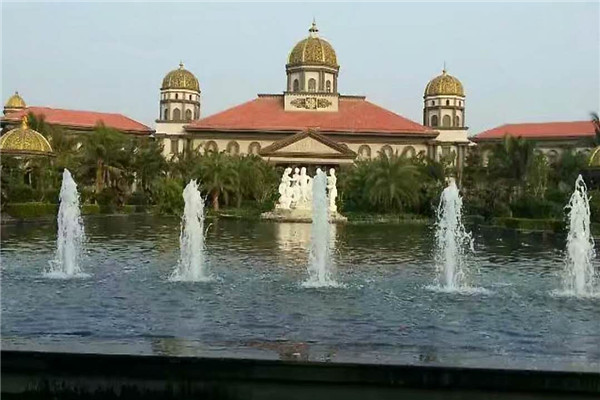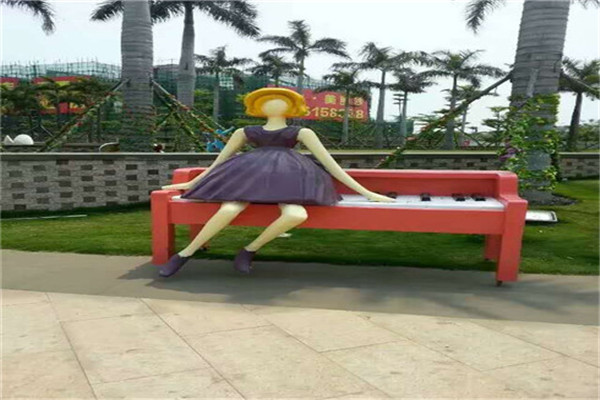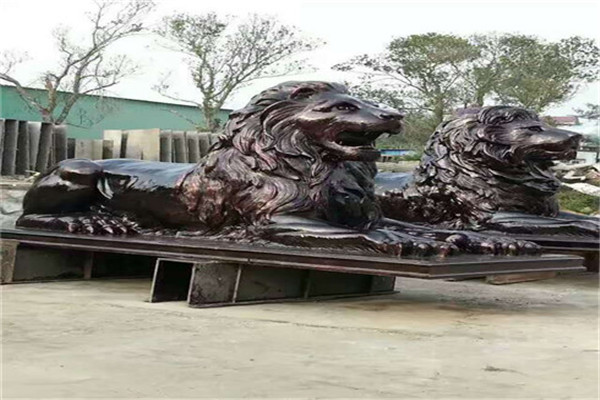
Circular sculpture, also known as three-dimensional sculpture, refers to non compressed three-dimensional sculpture that can be viewed from multiple directions and angles. Sculpture is the overall expression of art on the sculpture. The viewer can see all sides of the object from different angles. It requires the sculptor to carve from the front, back, left, right, top, middle and bottom. The techniques and forms of round sculpture are also varied, including realistic and decorative, concrete and abstract, indoor and outdoor, shelf and large city sculpture, colored and non colored, etc; The contents and themes of the sculptures are also rich and colorful, which can be characters, animals or even still life; The materials are more colorful, including stone, wood, metal, clay, gypsum, textiles, paper, plants, rubber, etc. It is mostly used in fountains, gardens and indoors. Because the round sculpture works are very three-dimensional, vivid, lifelike and vivid, the selection of stone materials is strict. First of all, we should design the shape of the sculpture, and pay special attention to the fact that the sculpture must have a proper proportion with the real object from length to width to thickness.

The rapid development of urban sculpture has increasingly become an important part of environmental art and the expression of urban image. Sculpture materials are mostly natural stone, artificial stone, wood, metal, cement and new materials such as plastic, rubber, stainless steel, aluminum alloy, gold copper, glass fiber reinforced plastic, etc. In order to cater to the trend of people's "returning to nature", break through the stereotype of traditional sculpture "steel and cement", enrich the environmental space, better protect and beautify the environment, reflect the meaning of sculpture, and make the urban landscape more attractive and cultural and artistic taste, "green sculpture" came into being at the historic moment, quietly sweeping all countries in the world. It refers to the artistic image with different postures and vivid charm, which is carefully cultivated and pruned by various green plants, especially trees. It combines garden and sculpture art, skillfully integrates the theme of "people, animals and nature" into beautifying the urban environment, and has a wonderful effect of shaping a beautiful image of the city and protecting the urban environment. The green sculptures are generally novel in design and rich in meaning. The overall style is beautiful and grand, full of modern flavor. Green sculptures are not only rich in materials, but also can release oxygen needed by human beings, absorb carbon dioxide, purify air, regulate air humidity, and bring health and artistic enjoyment to the city.

Exterior wall decorative panel is a new type of integrated material for building exterior wall decoration and insulation developed in recent years, which is composed of polyester baking paint or fluorocarbon paint, carved aluminum zinc alloy steel plate, polyurethane insulation layer and glass fiber cloth; It is mainly used for exterior wall decoration and energy-saving reconstruction of gymnasiums, libraries, school and hospital office buildings, villas and other buildings; The main functions are building decoration, heat preservation, energy conservation, heat insulation, sound insulation, waterproof and mildew proof. The metal surface decorative insulation board is a large external hanging wall board produced in industrialization. It has good durability and low maintenance cost due to dry installation construction. It integrates the external wall insulation and decoration functions, conforms to the development direction of building energy conservation "modularization" technology, and is an advanced technology vigorously promoted in the field of external temperature protection technology of building walls in China.

Relief is a kind of sculpture. The sculptor carves the image he wants to shape on a flat plate, making it separate from the plane of the original material. Relief is the product of the combination of sculpture and painting. It deals with objects in a compressed way, and displays three-dimensional space by perspective and other factors. It is only for one side or two sides to see. The reliefs are usually attached to another plane, so they are used more in architecture and can be seen on utensils and implements. Due to its compression characteristics, it occupies less space, so it is suitable for decoration in a variety of environments. In recent years, it has played an increasingly important role in urban beautification. The relief is as rich and colorful as the round sculpture in content, form and material. The materials of relief include stone, wood, ivory and metal. The relief is a semi vertical sculpture whose image shape protrudes from the stone surface (as opposed to the relief). It can be divided into light relief and high relief according to the depth of stone removal in image modeling. The bas reliefs are single level statues with relatively simple contents; The high relief is a multi-level statue with complicated contents. The carving technique and expression style of relief are basically the same as those of round sculpture. Many ancient and modern large-scale memorial buildings, high-end mansions and private houses are equipped with such decorations. Their main works are wall blocks, flower windows, dragon columns (early) and column bases.

Most of the jades mentioned in daily life refer to nephrite, and there are many kinds of nephrite products. Generally, they refer to white sheepskin jade, white jade, topaz, purple jade, black jade, jasper, sapphire, ruby and northeast Xiuyu produced in Xinjiang. recommend Sculpture customization In the jade carving, the white jade with sheepskin is fine in texture and strong in luster, as white as sheepskin, which can be called "the king of nephrite" and "the crown of white jade". In addition, Nanyang jade, Lantian jade, Hotan jade, agate, crystal, coral, turquoise, lapis lazuli, etc., all belong to the category of nephrite. Later, due to the opening of the Silk Road, the jade produced in Hotan, Xinjiang, was unanimously recognized and began to play a leading role in the processing of royal, official and folk jade. Sculpture customization Price Nephrite gradually evolved into a synonym for hotan jade.

Micro carving is a kind of carving technique that is good at small and fine. Chinese micro sculpture has a long history. Miniature carvings appeared in oracle bone inscriptions as far back as the Shang Dynasty. During the Warring States Period, the seal was as small as millet, but the seal was divided into white and black. Wang Shuyuan's Nuclear Boat Story, which is widely known, is also a classic work of micro sculpture in Chinese history. The art of seal cutting is the basis for the emergence and development of micro carving art. Since the Ming and Qing Dynasties, many literati and scholars have used iron pen to write and paint in the seal, to express their interest and entertain themselves. After Shoushan Stone became the seal material, the micro carving art of Shoushan Stone began to appear. At the beginning of the Qing Dynasty, Yang Xuan and Diaobin both carved small characters in the remote patterns of Shoushan stone carvings. Lin Qingqing, a master of "Ximen Boyi School" carving, also often wrote his name and date of production in the grass and stone crevices of the carved works with extremely fine pen. Later, some people carved ancient poems with extremely fine characters on the four sides of the square pillars of the seal as margin. In the 1960s, with the application of advanced scientific instruments such as magnifiers in the field of micro sculpture, micro sculpture art became a new and unique art. The words carved in the works are smaller and smaller, and the content is more and more. Microcarvings pay special attention to the selection of materials. The texture of the Hainan EPS component stone is required to be absolutely pure, and there should be no sand grid and half silk cracks, because half of the sand dot may be engraved with more than 10 Chinese characters. Secondly, the micro carving knife is also a special thin knife, which should be sharp and sharp. Third, it is necessary to have a particularly proficient knowledge of calligraphy and traditional Chinese painting. When carving, you can carry out "free engraving". Fourth, hold your breath and concentrate on your thoughts on the spot. Fifth, the knife should be handled steadily, accurately and ruthlessly. Only in this way can calligraphy and knife technique be perfectly unified. The art of micro sculpture is "art in micro". The more subtle it is, the more refined its kungfu is, and the higher its value is. Microcarving is also an art that pays great attention to the picture and organization, which is "intended to be refined". The sculptor of micro sculpture should first have a deep knowledge of calligraphy and painting. Although the micro sculpture is too small to be recognized with the naked eye, it is still very exquisite under the magnifying glass, such as large calligraphy works.






